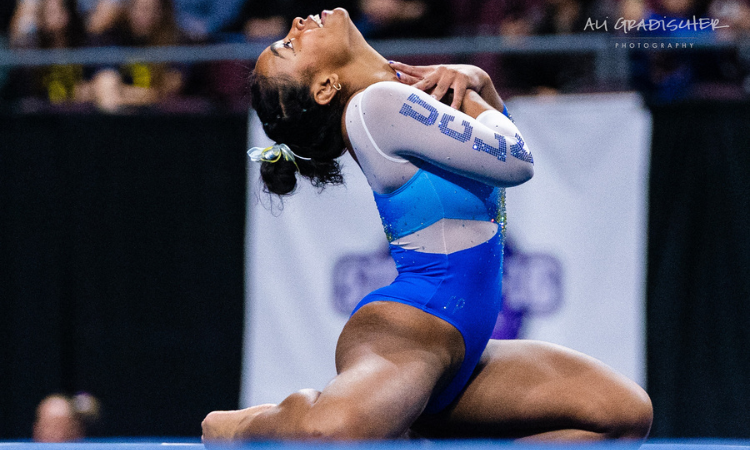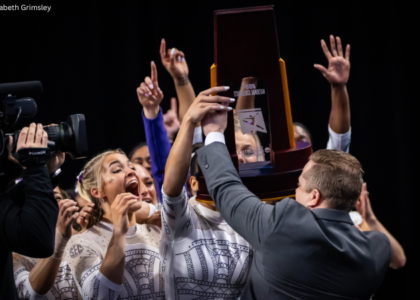It’s almost time for the NCAA gymnastics postseason again! We know where each of the top 36 teams in the country will travel to compete for a chance at advancing to nationals. In the days leading up to the championships, we’ll preview and analyze each of the four regionals, discussing which teams have a chance of moving on each day and which individuals could qualify as well.
First up is the Los Angeles regional. Wednesday will feature No. 33 BYU and No. 36 Boise State in round one. Thursday we jump into round two action with No. 5 Utah, No. 12 Auburn, No. 21 Southern Utah, and No. 27 Washington competing in the afternoon session and No. 4 UCLA, No. 13 Missouri, No. 20 Stanford, and the round one winner in the evening session. Two teams from each Thursday competition will advance to the regional final on Saturday, where the top two from that meet make it to nationals.
A handful of individuals will compete on Thursday in both of the round two meets. Simply put, the top all-arounder and event specialists qualify for nationals. To determine those gymnasts, combine Thursday’s individual event and all-around results, wait until Saturday’s meet concludes, remove all the gymnasts from the two qualifying teams, and take the top individual on each event and in the all-around.
Easy enough, right?
Check out our NCAA postseason resource guide for a more in-depth explanation, including how the tie-breaking procedure works (it’s complicated), how the whole format is structured, and even how judges are selected.
Round One
Date: Wednesday, March 29 at 5 p.m. ET
How to Watch: ESPN+
Teams: No. 33 BYU vs. No. 36 Boise State
| Team | NQS | Average | High Score | Starting Event |
| No. 33 BYU | 196.400 | 195.802 | 196.650 | Vault |
| No. 36 Boise State | 196.285 | 195.908 | 196.825 | Bars |
Background
After a slow start to the season, BYU settled into a near-weekly mid-196, highlighted by its bars and beam efforts. Boise State had a similar mid-196 season, finding consistency on vault to balance a drop in star power on bars.
So You’re Saying There’s a Chance
This play-in round should be almost as neck and neck as it gets, with Boise State having a slight edge. The Broncos have a higher ceiling and average by just a hair and are one of few teams nationally to have their average be higher than their NQS. On the flip side, frequent visitors on Road To Nationals will notice that the Cougars’ highest possible total from this season is 0.050 higher than the Broncos.
Routines You Shouldn’t Miss
BYU’s Anyssa Alvarado and Anna Bramblett are big names to watch for on bars but will meet their match in Boise State’s Courtney Blackson and Emily Lopez, who scored her program’s first 10.0 on the event. Bronco Adriana Popp’s front handspring pike half has come close to that mark and can again with a solid landing. MRGC beam champion Elease Rollins smiles through her routine and demands attention for those 90 seconds, while BYU teammate Rebekah Ripley does the same on floor.
Round Two
Session One
Date: Thursday, March 30 at 5 p.m. ET
How to Watch: ESPN+
Teams: No. 5 Utah, No. 12 Auburn, No. 21 Southern Utah, and No. 27 Washington
| Team | NQS | Average | High Score | Starting Event |
| No. 5 Utah | 197.910 | 197.789 | 198.550 | Beam |
| No. 12 Auburn | 197.480 | 197.266 | 197.750 | Floor |
| No. 21 Southern Utah | 196.820 | 196.375 | 197.125 | Bars |
| No. 27 Washington | 196.585 | 196.285 | 197.250 | Vault |
Background
Utah and Auburn had strong starts to their seasons, and both can separate themselves from Southern Utah and Washington early in the meet. They also have the upper hand from making the team final last season. However, they’ll (likely) be without their respective key all-arounders, Grace McCallum and Sunisa Lee. Southern Utah is fresh off of its first MRGC conference title and has no weak event this season, but it will have an uphill battle being placed in the same round as a very similar team from Washington.
So You’re Saying There’s a Chance
The Utes are a veritable lock, but the Tigers have been hit-or-miss in recent weeks without Lee’s steadying hand. They’ve scored a mid-196 twice in the last month, a mark that both the Huskies and the Flippin’ Birds can beat without too much trouble.
Routines You Shouldn’t Miss
A stuck vault can make or break a team’s chances at advancing, so we’ll look no further than last season’s national champion Jaedyn Rucker to get the job done for the Utes. Auburn’s Cassie Stevens has also found her share of stuck landings this year, going into regionals as the SEC co-champion and ranked eighth nationally. Underdog teams will bring their own big names to bars, including Washington’s Skylar Killough-Wilhelm and Southern Utah’s Shylen Murakami. Expect a beam masterclass between Utah and Washington in this session, highlighted by Maile O’Keefe and Kara Eaker. If sky-high tumbling is your thing, watch for Auburn’s Derrian Gobourne and Southern Utah’s Karley McClain.
| All-Around | Vault | Bars | Beam | Floor |
| Lauren Macpherson, San Jose State (with Washington) | Jaudai Lopes, San Jose State (with Auburn) | Emma Milne, San Jose State (with Auburn) | Ilka Juk, LIU (with Utah) | Jada Mazury, San Jose State (with Auburn) |
| Syd Morris, LIU (with Southern Utah) | Mara Titarsolej, LIU (with Utah) | Emma Milne, San Jose State (with Auburn) |
*Note: Individuals from both round one teams are included in the individual draw to account for one team being eliminated after Wednesday’s competition. The spots from the individuals on the advancing team will not be filled.
Individuals to Keep an Eye on
As with last season, all eyes will be on LIU’s Titarsolej to advance from regionals on bars. In her two seasons as a Shark, she’s produced the same quality routine week in and week out, always keeping her average above 9.900. This session also has three Canadians competing as individuals, with all three posing national qualification threats with hit routines: San Jose State’s Milne will compete bars and beam but will stand out on the latter for her fluidity, alongside Juk. Milne’s teammate Mazury has been a 9.9+ machine this season on floor and will round out the northern trio from this session’s individuals.
Session Two
Date: Thursday, March 30 at 10 p.m. ET
How to Watch: ESPN+
Teams: No. 4 UCLA, No. 14 Missouri, No. 20 Stanford, and the winner of round one.
| Team | NQS | Average | High Score | Starting Event |
| No. 4 UCLA | 197.950 | 197.702 | 198.275 | Beam |
| No. 14 Missouri | 197.115 | 196.961 | 197.850 | Floor |
| No. 20 Stanford | 196.930 | 196.579 | 197.575 | Bars |
| No. 33 BYU OR No. 36 Boise State | 196.400 / 196.285 | 195.802 / 195.908 | 196.650 / 196.825 | Vault |
Background
UCLA’s renaissance under its first-year head coach has been thoroughly impressive, as the team that finished 12th the past two seasons is now a legitimate threat to make Four on the Floor. Stanford is coming off of a disappointing performance at Pac-12 championships but is coming off one of its strongest seasons in years.
Last postseason’s Cinderella, Missouri, hasn’t been able to maintain its place in the top five but has turned up the heat in recent weeks: The Tigers haven’t scored below 197.000 in their last five meets, including a 197.850 program high at Arkansas in Week 8.
Finally, whichever MRGC team advances to the second round will—at the very least—field individual routines imminently capable of challenging for the event titles if not for a team bid to the final outright.
So You’re Saying There’s a Chance
UCLA would be heavily favored in this round even if it wasn’t competing at home. However, as the Bruins can attest after last year’s Raleigh regional, you shouldn’t sleep on Missouri during the postseason! Then there’s Stanford: This chaotic and talented team can score anywhere from a low 196 to a mid-197. The Tigers certainly have the edge heading into this match-up but will need to press their full scoring advantage against the Cardinal to ensure a spot in the final.
Routines You Shouldn’t Miss
Assuming UCLA qualifies to nationals as expected, Missouri has the best chance at snapping up the individual spots: SEC co-champion Jocelyn Moore has earned a 10 on vault this season and has come within a quarter-tenth of one on floor. Helen Hu is one of the country’s best bars and beam specialists, while Amari Celestine and Sienna Schreiber are reigning NCAA silver medalists on vault and beam, respectively. Also, watch for Stanford’s Chloe Widner, who’s notched 9.95-plus scores on bars, beam, and floor.
| All-Around | Vault | Bars | Beam | Floor |
| Hannah Demers, Central Michigan (with BYU or Boise State) | Kylie Eaquinto, BYU, or Courtney Blackson, Boise State (with Missouri) | Anyssa Alvarado, BYU, or Emily Lopez, Boise State (with Stanford) | Amber Koeth, Sacramento State (with Stanford) | Courtney Blackson, Boise State (with Missouri) |
| Sydney Benson, BYU, or Emily Lopez, Boise State (with Stanford) | Courtney Blackson, Boise State (with Missouri) | Elease Rollins, BYU (with Missouri) | Taylor Pitchell, Central Michigan (with Stanford) |
*Note: Individuals from both round one teams are included in the individual draw to account for one team being eliminated after Wednesday’s competition. The spots from the individuals on the advancing team will not be filled.
Individuals to Keep an Eye on: DeMers is the MAC Senior Gymnast of the Year for a reason: She’s the nation’s top all-arounder from outside the Power Five conferences and has gone north of 39.500 four times this season. An ideal outcome for Central Michigan sees DeMers qualify as an all arounder with teammate Pitchell getting the nod on floor. Meanwhile, Boise State’s triple threat Blackson could realistically challenge for the vault, bars, and floor spots, while her teammate Lopez is ranked 14th nationally on bars and scored the program’s first perfect 10 earlier this season.
Round Three
Date: Saturday, April 1 at 8 p.m. ET
How to Watch: ESPN+
Teams: Top two teams from each Friday session
| Vault | Team with the second-highest NQS |
| Bars | Team with the highest NQS |
| Beam | Team with the third-highest NQS |
| Floor | Team with the fourth-highest NQS |
The Bottom Line
Fans can expect close battles between who advances and who doesn’t, so prepare to see every session come down to the last routine. Utah, Auburn, UCLA, and Missouri are heavily favored to make round three, and from there, Utah and UCLA to qualify for nationals. No matter what configuration of the four seeded teams move on, one who went to nationals last year will be left out. We also can’t count out Stanford, who has only gotten stronger since 2022’s push from the play-in to round three.
READ THIS NEXT: The NCAA Postseason Format, Explained
Article by Claire Billman and Peri Goodman
Like what you see? Consider donating to support our efforts throughout the year!





Great article! In the second paragraph, Utah is mistakenly listed where UCLA should be for the evening session.
Thank you! We will make that update.
Great article! There’s a typo: Boise State high score should be 196.825, not 195.825.
Thanks for catching that! We will make the update.